![]()
![]()
![]()
Use LEFT and RIGHT arrow keys to navigate between flashcards;
Use UP and DOWN arrow keys to flip the card;
H to show hint;
A reads text to speech;
49 Cards in this Set
- Front
- Back
- 3rd side (hint)
|
What gland releases somatotropin (growth hormone)? What does this hormone do? |
- Anterior pituitary (found in brain) - Dramatically increases blood sugar levels. |
|
|
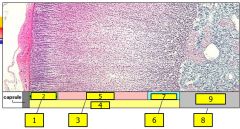
Adrenal glands 1 |
= Mineralocorticoids - Secreted by zona glomerulosa in adrenal cortex. - E.g. aldosterone - Help regulate blood volume, blood levels of K and Na ions. - Stimulates excretion of K ions. - Stimulates reabsorption of Na ions. - Draws in water so increases blood volume and pressure (indirectly) |
- Hormone - Where secreted from - What is does. |
|
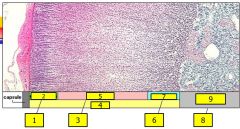
Adrenal glands 2 |
= Zona Glomerulosa - Outer layer of adrenal cortex - Secretes mineralocorticoids. |
What Where What is secretes |
|
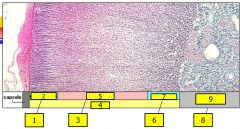
Adrenal glands 3 |
= Glucocorticoids - Secreted by zona fasciculata in adrenal cortex. - 2 major = cortisol and cortisone/hydrocortisone - Released following biological stress = stress hormones. - Anti-inflammatory and promote gluconeogenesis. - Also causes immunodepression. |
- Hormone - Where secreted from - What it does |
|
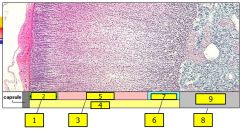
Adrenal glands 4 |
= Adrenal cortex - Secretes three important groups of steroid hormones. - Their release is regulated by ACTH which is released from anterior pituitary. |
|
|
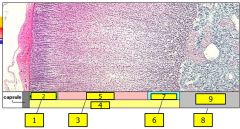
Adrenal glands 5 |
= Zona fasciculata - Middle region of adrenal cortex - Secretes glucocorticoids. |
What where What is secretes |
|
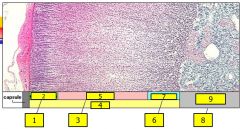
Adrenal glands 6 |
= Sex steroids = adrenal androgens - Secreted by zona reticularis of adrenal cortex. - Stimulate the development of male sexual characteristics. - Little effect in males. - Increases sex drive in females. |
Hormone Where secreted from What it does |
|
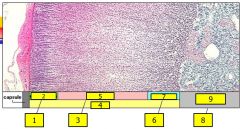
Adrenal glands 7 |
= Zona reticularis. - Inner region of adrenal cortex. - Secretes sex steroids. |
What where what it secretes |
|
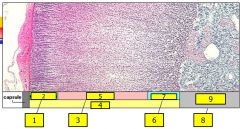
Adrenal glands 8 |
= Adrenaline (80%) and noradrenaline (20%) (catecholines) - Secreted by adrenal medulla. - Prepares body in emergencies = fight or flight response. - Increase heart rate and force of contraction = increased blood flow to muscles. - Increase breakdown of fats and stimulate breakdown of glycogen into glucose = sudden release of sugar into blood |
Hormone where secreted from what it does |
|
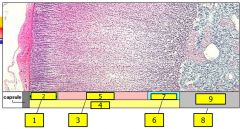
Adrenal glands 9 |
= Adrenal medulla - Inner region of the adrenal glands - Secretes adrenaline and noradrenaline. |
|
|
|
Where are the adrenal glands located? |
- 2 glands - Triangular in shape - One superior (cranial) to each kidney (sat on top of kidney) |
|
|
|
What regulates production of hormones from adrenal cortex? |
= ACTH (adrenalcorticotrophic hormone) - Released by anterior pituitary. - Without it adrenal cortex atrophies. |
|
|
|
Gluconeogenesis |
= Formation of glucose from non-carbohydrates such as proteins or lipids - Promoted by glucocorticoids (cortisol, cortisone. - Increases breakdown of fats and proteins. - Converts them into different sources of energy. - Glucose and fatty acids are released into circulatory system and taken up by tissues as energy sources. - Happens when on a diet |
|
|
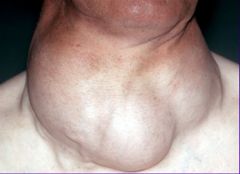
|
= Goitre - Can develop from both hyper and hypothyroidism. |
|
|
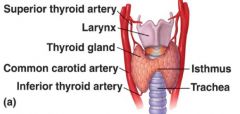
|
= Thyroid gland - Secretes 3 hormones 1. Triiodothyronine (T3) 2. Thyroxyne (T4) 3. Calcitonin - They increase metabolic activity. |
Gland What is secretes (3) What they do |
|
|
Disorders of the adrenal cortex |
1. Androgenital syndrome 2. Addison's disease 3. Cushing's syndrome |
|
|
|
Androgenital syndrome |
= Excess sex steroids = Masculisation of females e.g. muscles and body hair. |
|
|
|
Addison's disease |
= Adrenocortical insufficiency - Decreased secretion of steroid hormones from adrenal cortex. - Reduced response to adrenaline and noradrenaline - Can be fatal if not corrected. |
|
|
|
Cushing's syndrome |
= Excess of cortisol. - Depressed immune system - Stretch marks by prevention of formation of collagen and elastin fibres in skin. - Catabolism of protein = muscle wasting - Decrease protein synthesis - Weakening of bones. - Increase BP and blood glucose - Body fat redistributed from lower to upper parts of body. |
|
|
|
Hypothyroidism |
= Not enough thyroid hormones. - Infants = cretinism. - Adults: - Decreased metabolic rate - Weight gain, reduced appetite. - Dry, cold skin - Weak, flabby skeletal muscles, sluggish. - Myxedema - Apathetic, sleepy. - Course hair, rough skin. - Decreased iodine uptake. - Possible goiter. |
|
|
|
Hyperthyroidism |
= Excess thyroid hormones. - Increased metabolic rate. - Weight loss/increased appetite. - Warm, flushed skin. - Weak muscles with tremors. - Exophthalmia (protruding eyes) - Hyperactivity/insommnia. - Soft, smooth hair and skin. - Increased iodine uptake. - Goiter. |
|
|
|
What two organ systems does the pancreas belong to? |
Digestive Endocrine |
|
|
|
What is the endocrine part of the pancreas? |
Islets of Langerhans (pancreatic islets) randomly scattered throughout the pancreas. |
|
|
|
What are the two pairs of antagonistic hormone that the Islets of Langerhans in the pancreas produce? |
1. Insulin and glucagon 2. Ghrelin and pancreatic polypeptide. |
|
|
|
What two hormones are involved in the control of blood sugar? |
Insulin and glucagon |
|
|
|
What two hormones are involved in the control of appetite? |
Ghrelin and pancreatic polypeptide. |
|
|
|
Type of Islet cell that produces insulin |
Beta (70%) |
|
|
|
Type of Islet cell that produces glucagon |
Alpha (5-20%) |
|
|
|
Type of islet cell that produces Ghrelin |
Epsilon cells |
|
|
|
Type of islet cell that produces pancreatic polypeptide |
PP cells |
|
|
|
Hunger hormone |
= Ghrelin. - Levels spike just before you eat meals. - Binds to hypothalamus to induce hunger. - Released by epsilon cells |
|
|
|
Satiety hormone (makes you feel full after food) |
= Pancreatic polypeptide - Released after eaten protein or fat. |
|
|
|
What are low level of pancreatic polypeptide hormone linked to? |
Obesity and type II diabetes mellitus |
|
|
|
What are high levels of pancreatic polypeptide hormone levels linked to? |
Anorexia Nervosa |
|
|
|
Hormone that increases blood sugar |
Glucagon |
|
|
|
True/false Every alpha and beta cell is in contact with a blood vessel |
True. Alpha cells produces glycogen Beta cells detects raised blood sugar and produces insulin |
|
|
|
Action of glucagon |
1.Increases blood glucose levels 2. Act on liver. 3. Induces production of glycogen phosphorylase. 4. This initiates the splitting of glycogen and so the release of glucose. |
|
|
|
Action of insulin |
1. Only hormone that can lower blood sugar. 2. Relies on a protein =Glut4 (=glucose transporter) 3. Glut4 moves to cell membrane and fuses to it. Allows glucose to enter cell. |
|
|
|
Effects of insulin |
1. Lowers blood glucose 2. Increases uptake of glucose by cells. 3. Increases formation of glycogen (insoluble) from glucose (soluble) by the liver. 4. Increases lipid synthesis when run out of storage space for glycogen, so get fat. 5. Tells cells to take up amino acids = increase protein synthesis particularly muscle growth. |
|
|
|
Two types of diabetes. |
- Type I = Insulin dependent diabetes mellitus - Type II = Non-insulin dependent diabetes mellitus. - Gestational diabetes =develops during pregnancy |
|
|
|
Type I diabetes |
= Insulin dependent diabetes mellitus. - Controlled with insulin injections - Auto immune disease which results in destruction of Beta cells = little/no insulin production. - 10% of diabetes sufferers. - Usually children and young adults. |
|
|
|
Type II diabetes |
= Non insulin dependent diabetes mellitus. - Resistance to the action of insulin. (insulin receptor on cells blocked) - Generally found in people over 40 and overweight. - Possible link between type II and high fructose corn syrup (found in sweetener/processed food) |
|
|
|
Type I diabetes linked with ? |
Mumps virus Alzheimer's disease as linked to build up of amyloid deposits in the brain. |
|
|
|
What is diabetes mellitus characterised by? |
= hyperglycaemia. - blood sugar >7.5 mmol. |
|
|
|
What organ dysfunction/damage is chronic hyperglycaemia associated with? |
- eyes - kidneys - nerves - heart - blood vessels. |
|
|
|
Gestational diabetes |
- 4% of pregnancies - Linked to high levels of progesterone during pregnancy. - High birth weight babies - Increased risk of type II later in life. |
|
|
|
Symptoms of diabetes |
1. Hyperglycaemia 2. Polyuria (passing large amounts of urine) 3. Glycosuria (sugar in urine) 4. Polydipsia (persistent thirst) 5. Ketoacidosis (smells like pear drops) 6. Polyphagia (always hungry) |
6 |
|
|
Ketoacidosis |
- Cells not able to take up glucose (=starving) - Stress hormones (cortisol) released from adrenal cortex. - Promotes fat breakdown to provide energy for cells. - During lipolysis ketones are released into blood leading to ketoacidosis and maybe coma. |
|
|
|
Consequences of diabetes. |
1. Atherosclerosis (build up of fatty deposits/plaque in blood vessels. 2. Damage to endothelium of blood vessels 3. Peripheral vascular disease. 4. Claudication (limping) 5. Diabetic foot. 6. Angina 7. MI 8. Diabetic retinopathy |
8 |

